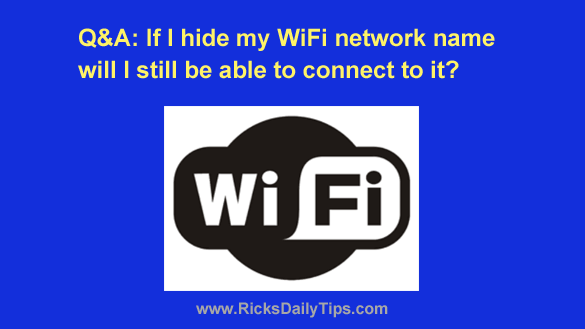Rick’s Tech Tips Newsletter
 Question from Jennie: I overheard a conversation the other day that really interested me, and I want to see what you think about it.
Question from Jennie: I overheard a conversation the other day that really interested me, and I want to see what you think about it.
A young man told his friend that hiding the WiFi network name in his router would prevent his neighbors from finding and connecting to the Internet over his network.
I live in an apartment building and I’m pretty sure I have this same problem right now.
I’d like to follow that guy’s advice but I want to make sure I can connect new devices of my own (as well as those of friends) to my WiFi network with the network name hidden. Will I be able to?
Rick’s answer: Jennie, the short answer is yes. You’ll just have to enter the network name (your router refers to it as the SSID) manually every time you attempt to connect with a new device. This is no big deal as long as you can remember the name you gave your network.
That being said, I don’t think that hiding the name of your network is the best solution to your problem.
If someone is piggybacking on your Wi-Fi connection you either have it set up as an open, non-password protected network or your password is so weak that they were able to hack it.
While changing the SSID and then hiding it would prevent the average gal or guy from finding your network and connecting to it, a hacker would still be able to be piggybacking off it in minutes because they have access to tools that sniff out hidden networks.
I would recommend that you do three things to protect your WiFi network:
1 – Enable the strongest encryption method that’s supported by your router and all of your WIFI devices. Your router’s user manual should have instructions for doing that.
2 – Change your WiFi password (aka WiFi security key) to one that is easy to remember yet extremely difficult to crack. This post explains how.
3 – Use the Fing app on occasion to check to make sure there aren’t any strange devices that logged into your WiFi network.
I hope this helps, Jennie. Thanks for asking such a great question.